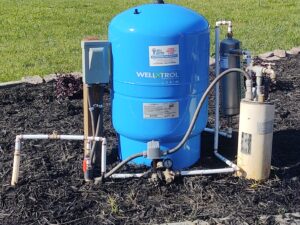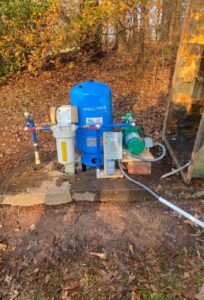Why Does My Well Pressure Tank Feel Empty
Well Pressure Tank Problems? Here’s What You Need to Know Before You’re Left High and Dry
Picture this: You’re in the middle of a hot shower, and suddenly your water pressure drops to a dribble.  You poke your head out, confused, shampoo still in your hair, wondering if someone flushed a toilet. Nope—welcome to the wonderful world of well pump pressure tank issues.
You poke your head out, confused, shampoo still in your hair, wondering if someone flushed a toilet. Nope—welcome to the wonderful world of well pump pressure tank issues.
While your well and pressure tank combo is usually a reliable, behind-the-scenes hero, it’s not invincible. Over time, things can go wrong—sometimes slowly, sometimes all at once. And when they do, you might be looking at sputtering faucets, unpredictable water pressure, or no water at all.
Let’s break this down so you can spot trouble early, fix it before it becomes a big problem, and maybe even impress your neighbors with your sudden water-well wisdom.
Why Your Well Pressure Tank Matters
Think of your well pump and pressure tank as a tag team.
-
The pump is the muscle, pulling water up from the ground.
-
The pressure tank is the storage brain, keeping water ready and maintaining steady pressure.
Without a working well pressure tank, your pump has to cycle on and off constantly. That’s bad news—it can triple your repair bill and burn out your pump faster than you can say “dry shower.”
How Long Does a Pressure Tank Last?
It depends on:
-
Quality of the tank: Cheaper models might last 5 years. High-quality tanks? Up to 30 years.
-
Water quality: Grit, sand, or sediment act like sandpaper on the tank’s insides.
-
Pump cycling: Too much on-off cycling is like doing 1,000 squats a day—things will break faster.
On average, a good tank lasts about 15 years if maintained properly.
Warning Signs You’ve Got Trouble Brewing
If you notice these, it’s time to investigate (or call in the pros):
-
Pressure gauge needle is jumpy – bouncing between high and low every 20–30 seconds.
-
Tank feels “full” all the time – should sound hollow at the top when tapped.
-
Pump turns on way too often – a big red flag for bladder or diaphragm trouble.
-
Water sputtering from faucets – can mean trapped air or failing components.
Common Culprits
-
Blown bladder or diaphragm – The rubber part inside your tank gives out, and water takes over the air space.
-
Faulty pressure switch – The control that tells your pump when to turn on/off misfires.
-
Well pump issues – Mechanical failure or loss of power to the pump.
-
Well problems – Low water levels, plumbing leaks, or sediment build-up.
 Troubleshooting Like a Pro (or at Least Pretending to Be One)
Troubleshooting Like a Pro (or at Least Pretending to Be One)
-
Kill power to the pump before touching anything.
-
Drain the tank completely.
-
Check the air pressure—should be about 2 psi below your cut-in pressure (commonly 38 psi).
-
If readings are way off, or you hear sloshing inside a “full” tank, you’ve probably found your issue.
Pro Tip: Prevention Saves Money
Regularly check your system, listen for odd noises, and don’t ignore fluctuating pressure. Early action means cheaper repairs, longer tank life, and fewer cold-shower surprises.
If your tank’s acting up, and you’d rather not crawl around in your basement with a wrench, call Well Doctor LLC. We’ll diagnose, repair, or replace your system—without the guesswork.




 Troubleshooting Like a Pro (or at Least Pretending to Be One)
Troubleshooting Like a Pro (or at Least Pretending to Be One)